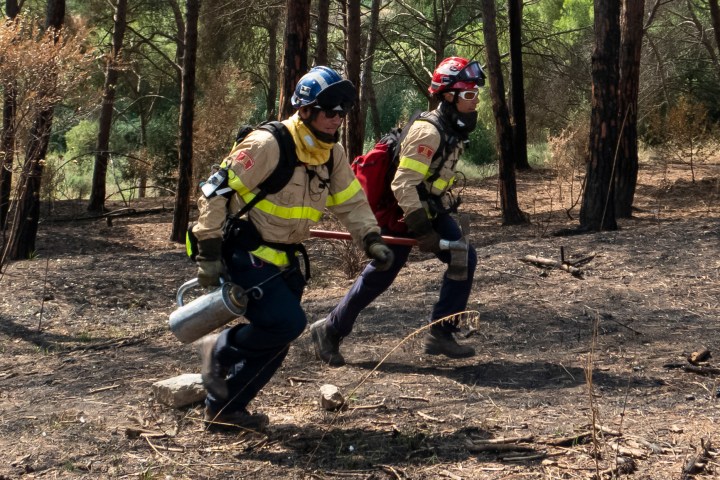
When your occupation explicitly requires you to go into places everyone else is desperately trying to flee, you know you’re performing a service few people would be capable of. But could technology help make firefighters’ jobs a bit less dangerous? That’s the hope of Prometeo, a Spanish team that has won IBM’s Call for Code 2019 competition.
The contest, which received 5,000 entries from 165 nations, aims to create and deploy open-source technologies to tackle some of humanity’s biggest challenges. “[Call for Code is] a perfect balance between technology and helping others,” Josep Ràfols, team captain of Prometeo, told Digital Trends. The team was announced as the contest winners at a special event in New York City on Saturday, October 12.

Prometeo has developed an A.I.-based platform that’s able to monitor firefighter health and safety in real time. It does this using a wearable device, about the size of an iPhone, which gathers environmental data about the conditions firefighters are experiencing. This can then be used to create individualized strategies or provide notifications about firefighters’ cumulative exposure to smoke and toxic substances as they work.
“It’s incredible if I tell you that, today, there is no such program that can report and monitor the health of firefighters,” Ràfols said. “What we tried to do was to use a combination of sensors, machine learning, and basic IT to record all the things that are happening with a firefighter when they are dealing with a fire.”
Monitoring the health of firefighters
Ràfols is one of five members of the Prometeo team, which also includes two other computer scientists, a 33-year veteran firefighter, and an emergency services nurse with a Ph.D. in toxicology.
With our product, you could decide which firefighters to send into a fire based on how much they have been exposed to [noxious gases].
As Ràfols is quick to acknowledge, the hardware component of the Prometeo project is fairly basic. “It’s something you can buy easily on Amazon or eBay,” he said. “It’s a very cheap microcontroller, costing about $10 — or less if you were to bulk buy. We then attach some sensors for [things like] temperature, humidity, and smoke concentration.”

Like a lot of Internet of Things (IoT) connected devices, the magic is what happens on the software side. The sensor data is transmitted via Wi-Fi to the IBM cloud IoT platform. It’s then run through an IBM Watson-based machine learning mode, which turns this raw information into a simple traffic light-style color-coded system.
Prometeo’s dashboard gives different colors for the firefighters it monitors: Green to indicate that a firefighters’ health is OK, or yellow or red to signal that action must be taken to rescue or remove them from a fire. “They will be more aware of their limits,” Ràfols said.

The technology can also be used to take a longer-term view. Prometeo’s system means that firefighters — and those responsible for deploying them — can view historical data as well. This could be used to monitor health and exposure over time.
“The technology is also there to analyze, long-term, the health of firefighters,” Ràfols said. “With our product, you could decide which firefighters to send into a fire based on how much they have been exposed to [noxious gases].”
Moving forward, saving lives
The project is still in the early stages. Having picked up their big Call for Code win, the team will next carry out field tests using firefighters in the Catalonia region of Spain. This will provide much-needed data. Some of this can be used for developing better predictive models to help make the technology work better. It will also give valuable feedback that can be used for honing the next generation of device prototypes.

“Right now, the [devices] we are using are very handmade,” Ràfols said. “We need them more resistant so that they can be used by firefighters [in real situations]. We want to make better casing.”
He explained that the team also hopes to expand the functionality of the devices to measure for additional gases. They also hope to add other features such as GPS for location awareness, concentration of oxygen in the blood, and heart rate. As part of Prometeo’s award, it will receive open-source support from IBM and the Linux Foundation. Open-sourcing the project will make it possible for researchers from all around the world to contribute their insights.
Ultimately, it’s not clear when (or even whether) Prometeo will commercialize its product. However, the $200,000 cash prize for winning the 2019 Call for Code competition, along with the meetings with mentors and potential investors it will set up, makes the prospect more likely.
One thing’s for certain: With wildfires on the rise, this is exactly the kind of technology that could make a big difference. Between this, drones for predicting where fires will spread, and robots that help support fire services, we could be entering a whole new world of firefighting technology. And that’s most definitely a good thing for everyone.




